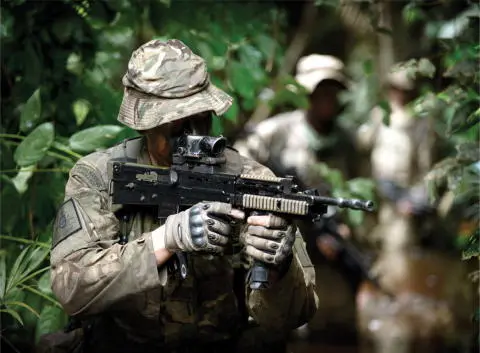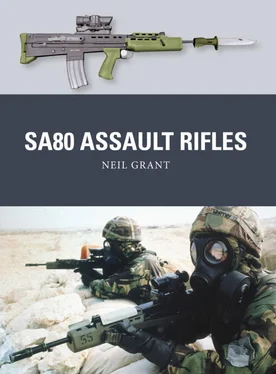One ‘PR’-series LSW was produced, by converting one of the three ‘PR’ IWs above, and fitted with a new forward-folding bipod. Testing of these weapons indicated that work was needed to resolve the outstanding problems, and it was agreed to delay the User Trials by three months, until October 1981. These ‘PR’ weapons were followed by the main production of the XL70 series, chambered for the 5.56mm cartridge. A total of 51 IWs were built, in both right-handed (XL70E3) and left-handed (XL78E1) configurations. In addition, 34 XL73E2 LSWs were produced, all in right-handed configuration; and since far fewer LSWs would be required, it was decided that no left-handed conversion kits would be produced. Externally, the main difference from the ‘PR’ weapons was a welded-on extension to the magazine housing, which protruded beneath the weapon’s body to give more support to the magazine. Internally, the gas system was modified, the bolt carrier and recoil guide-rod assembly was redesigned, and the extractor was replaced with a new design. Although the LSW had originally been intended to fire from a closed bolt on semi-automatic (for accuracy) and an open bolt on full-automatic (for better cooling), the XL73E2 fired from open bolt in both modes, significantly simplifying the mechanism.
As an experiment, one LSW was modified to fire from the closed bolt on both single-shot and full-automatic, using the trigger mechanism from an IW, and this ultimately became the preferred option. While firing from a closed bolt improved LSW accuracy, the problem of chamber overheating and the attendant ‘cooking-off’ problem – the reason the open-bolt option had been added in the first place – now returned, reducing the LSW’s sustained-fire capability.

An XL70E3 IW camouflaged with green tape and fitted with an image-intensifier night sight. (Cody Images)
THE ORDNANCE BOARD AND ITDU TRIALS
The Ordnance Board trials were intended to identify technical problems for correction before series production, and ran in parallel with the User and Troop Trials. Weapons were put through a number of tests including mud baths, drop testing and sustained-fire reliability tests, as well as being exposed to extremes of heat and cold. The methodology used would be criticized later by the Cabinet Defence Select Committee, for being too ‘clinical’ and using environmental chambers rather than testing how the weapons would actually be used by soldiers. For example, the icing tests were conducted by spraying the weapons with water in a freezer, which failed to replicate the effects of wind-driven snow clogging every opening in the weapon when troops actually deployed with it to Norway. Reliability was defined by ‘Mean Rounds Between Failures’ (MRBF), with a target of 2,500 rounds for the IW and 8,000 rounds for the LSW; the latter figure was obviously very ambitious, since the LSW had essentially the same mechanism as the rifle. Failures were classified into three categories:
(1) ‘Minor’ incidents could be rectified by the user employing the standard ‘Immediate Action Drills’, e.g. re-cocking the weapon to load a new cartridge after a misfire;
(2) ‘Serious’ incidents could be rectified by the user but needed more action, e.g. by stripping and cleaning the weapon to remove excessive fouling;
(3) ‘Critical’ incidents could not be rectified by the user, e.g. parts breakages.
The MRBF calculation counted only critical failures. While this was not intrinsically wrong – any MRBF target including the less serious categories would have necessarily been much lower – it did have adverse consequences. Since nothing except critical failures affected the MRBF target, the other categories were essentially ignored and little attention was paid to rectifying the causes, no matter how frequently they occurred. By contrast, troops in combat suffering stoppages every couple of magazines were unlikely to find this acceptable even if these were technically ‘minor’ incidents that did not affect the reliability target.

This Royal Marine of 45 Commando with his L85A2 camouflaged with self-adhesive white plastic is pictured during an exercise in Norway. (MOD © Crown copyright 2010)
The MRBF calculation also led to a certain amount of manipulation as the LSW struggled to meet the reliability target. For instance, a fractured bolt was initially classified as a ‘critical’ failure. If a spare bolt was included in the tool wallet, however, the same incident immediately became something the user could theoretically rectify – no matter how unlikely in practice – and thus became merely a ‘serious’ incident which did not count toward the MRBF. Artificial as this may be, it is exactly what was recommended, and a complete replacement bolt was added to the LSW tool wallet for the trials. Once the MRBF target had been met, however, the standard contents of the wallet were quietly revised – and the spare bolt disappeared before issue.
The IW initially achieved an MRBF figure of 1,250, but this was ‘corrected’ to 2,500 by ignoring ‘critical’ failures caused by issues the design team believed could be eliminated by design changes before production; a rather optimistic way of conducting reliability trials. The LSW scored significantly better – 2,713 for rounds from an open bolt and 4,746 for shots from a closed bolt – but still fell well short of the target figure, even after correction. Both weapons were found to be very accurate in single-shot mode; but while the first round on automatic was generally on target, subsequent rounds were well off-target, particularly at longer range. This was inevitable to some extent, as muzzle climb on automatic will always push the weapon off-target. The effect was more severe than expected, however, especially for the LSW where the bipod should have stabilized the weapon. Rounds also started ‘cooking off’ after firing about 330 rounds at a rate of one per second – well above the rate at which a rifle would be fired, but not above that expected of a machine gun. Other problems included issues with the bipod catch and cracking of the bolt carriers.
The SA80 system was also assessed by the Army’s Infantry Trial & Development Unit (ITDU), in parallel with the Ordnance Board trials. The ITDU trials were not intended to assess reliability – that would be tested by the Ordnance Board – but to assess usability and effectiveness. For instance, the ITDU expressed concern that the LSW did not meet the requirement to deliver effective suppressive fire. Despite this, its final report indicated that ‘the IW proved itself to be a robust and reliable weapon that suffered few stoppages… the majority of the problems previously noted have now been overcome’ (quoted in Raw 2003: 85).

A Royal Marine of 45 Commando during a multi-national exercise at the Jungle Warfare School, Ghana in 2013. (MOD © Crown copyright 2013)
During the trials, the XL70-series weapons were replaced by the XL85E1 IW and XL86E1 LSW. These would effectively be the production build standard, and incorporated a number of changes. Only right-handed versions of both weapons were produced, the requirement for a left-handed version having been effectively dropped – a conversion kit was promised, but never materialized. The RSAF final report noted that the required MRBF for the LSW had still not been met, though the design team remained optimistic that this could be achieved. Overall, the acceptance meeting agreed to adopt the IW, and give limited approval for production of an initial tranche of 30,000 weapons. Concerns remained over the LSW’s accuracy on automatic and its ability to deliver a sufficient weight of suppressive fire, however. Its adoption was therefore deferred until these issues could be resolved.
Читать дальше















